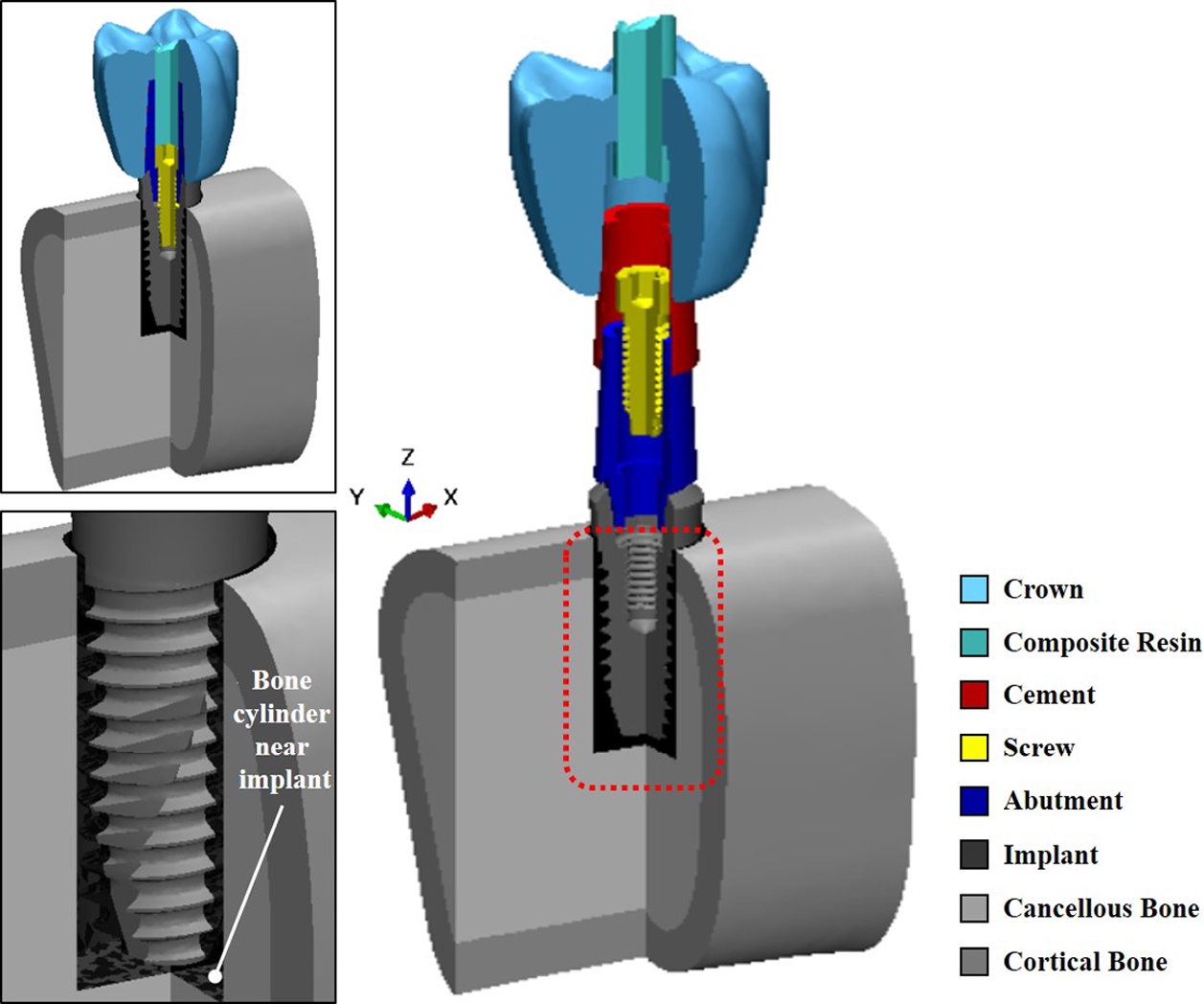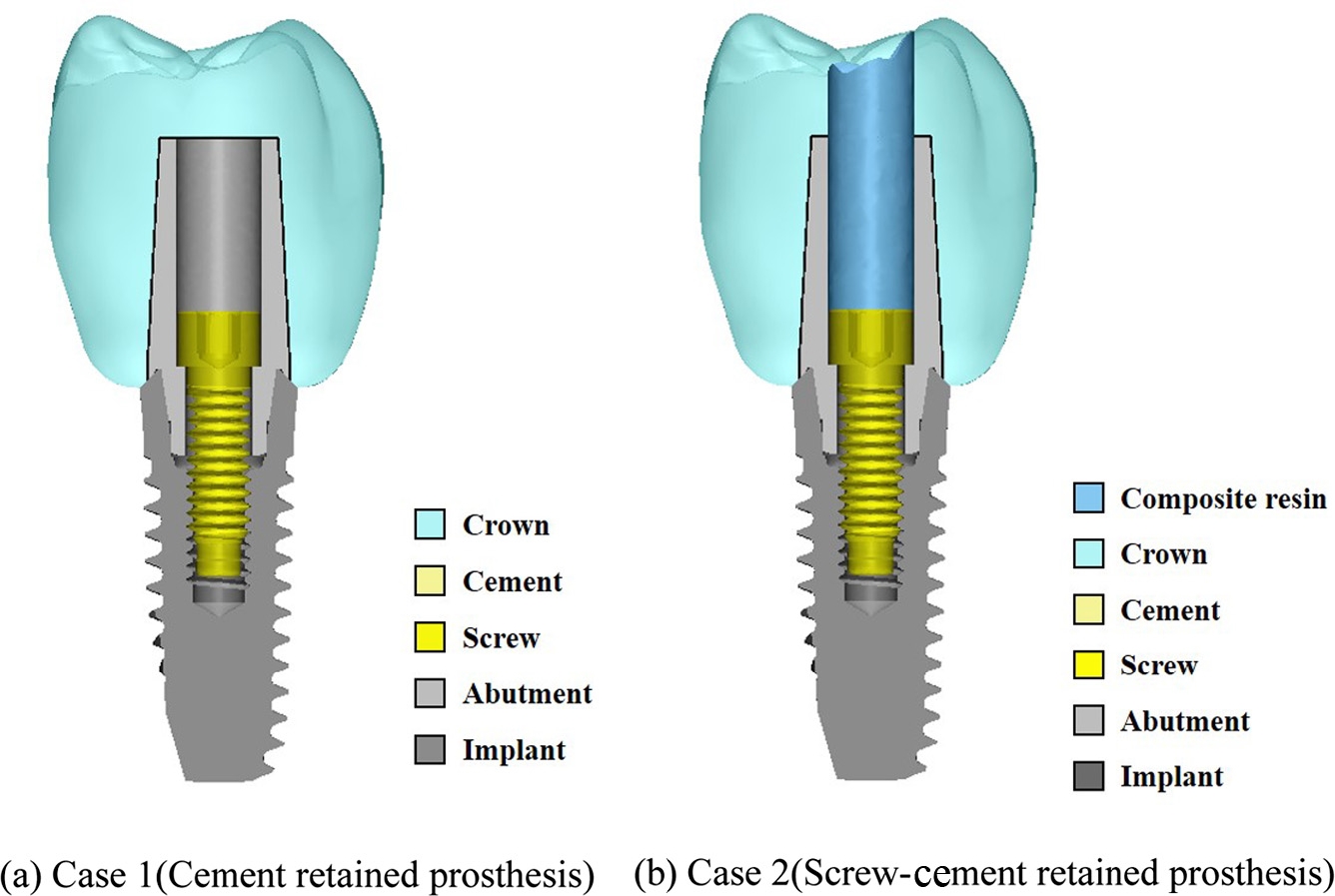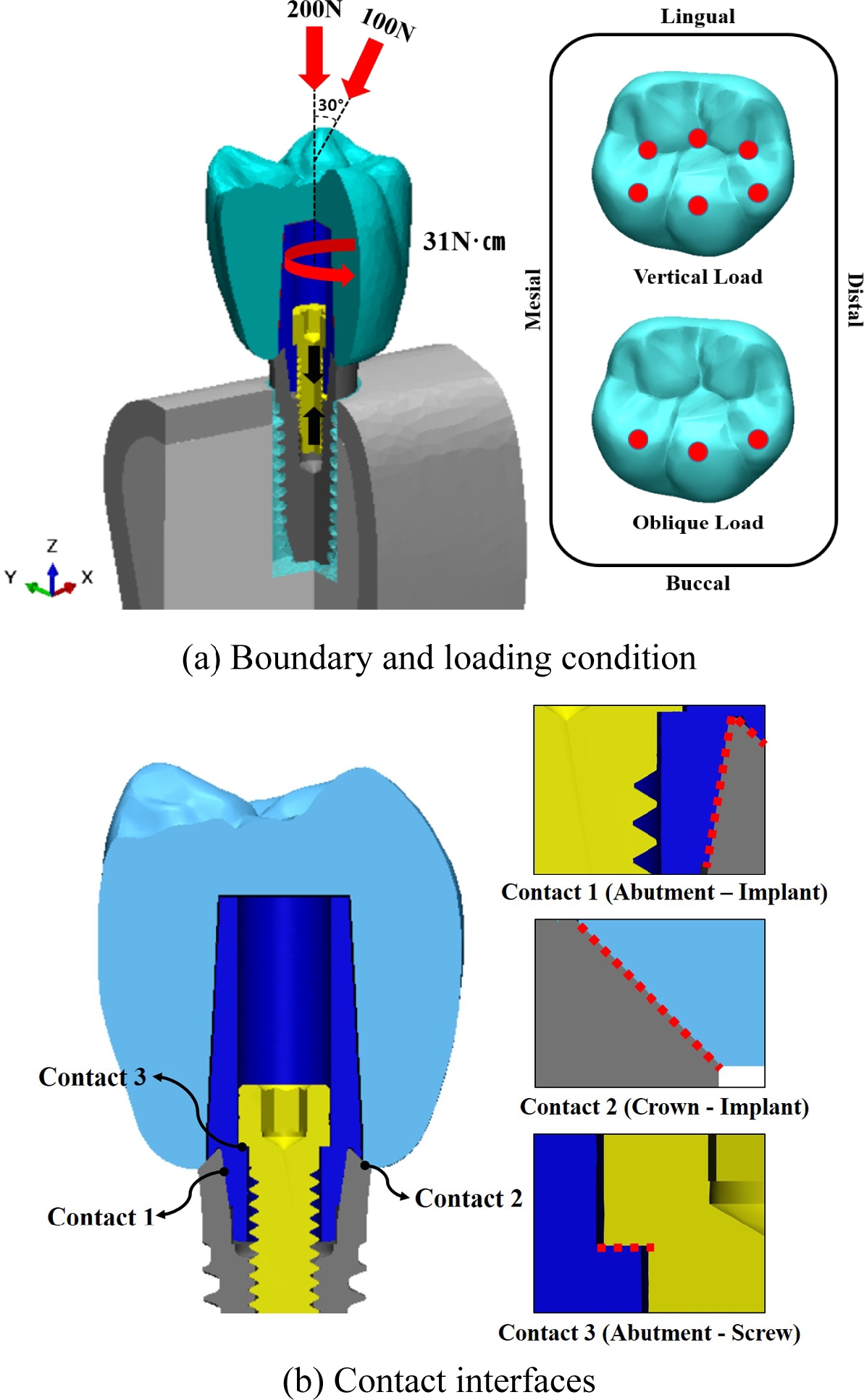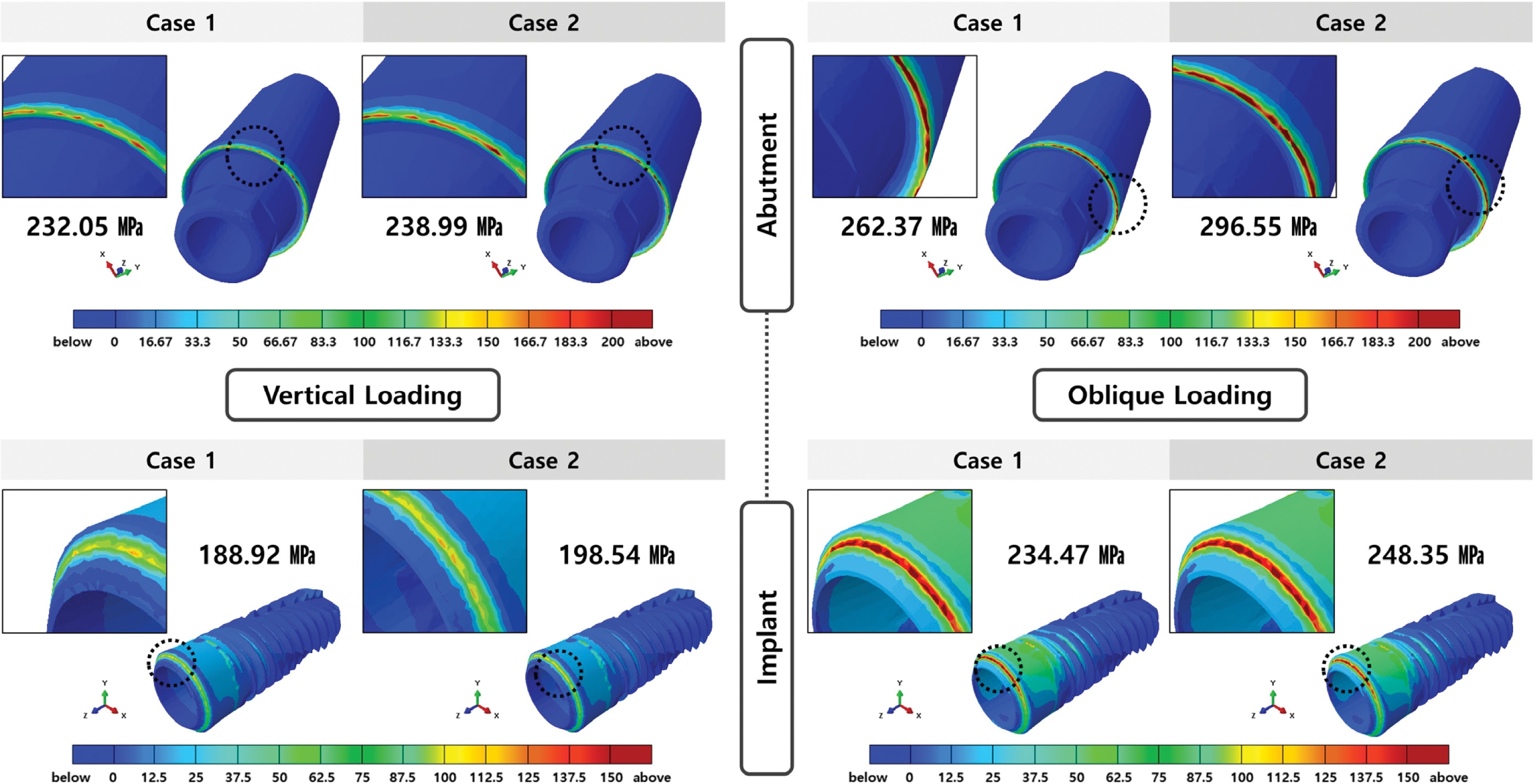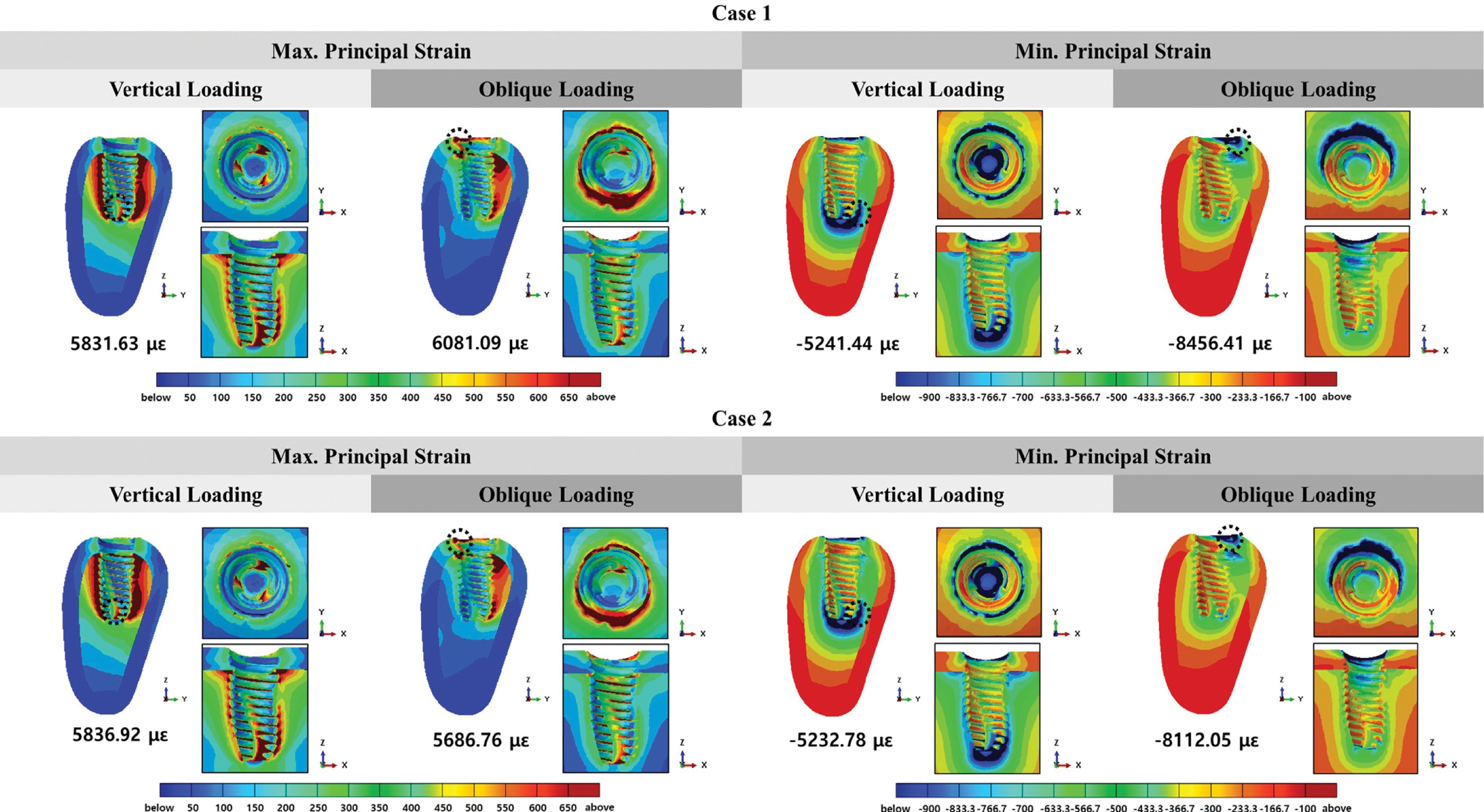
임플란트 최종 보철물 유지 형태(시멘트 유지형 및 나사-시멘트 유지형)에 따른 생체역학적 효과
Copyright © The Korean Society for Precision Engineering
This is an Open-Access article distributed under the terms of the Creative Commons Attribution Non-Commercial License (http://creativecommons.org/licenses/by-nc/3.0) which permits unrestricted non-commercial use, distribution, and reproduction in any medium, provided the original work is properly cited.
Abstract
For esthetic and functional implant prosthesis, the retention type of implant should be selected considering the oral condition of the patient. However, studies on the differences in biomechanical stability of the retention type are scarce. The purpose of this study was to evaluate the biomechanical effects between retention types in implant prosthesis using 3-dimensional finite element analysis. Two retention types (Cement and Screw-Cement) were considered for the implant complex consisting of the ComOcta abutment, SS type implant, and screw all implanted in the mandibular segment of the bone block. Static finite element analysis was performed under external loads of 200 N (Vertical Load) and 100 N (Oblique Load) to each cusp tip. We measured the von-Mises stress fields in abutment and implant, and the principal strain distribution of the mandibular bone to evaluate the risk of fatigue failure in the bone. Separations between the implant components were also evaluated. The results show that with the ComOcta abutment Cement type provided enhanced stability.
Keywords:
Finite element analysis, Dental implant, Implant prosthesis, Cement retained prosthesis, Screw-cement retained prosthesis키워드:
유한요소해석, 치아 임플란트, 임플란트 보철, 시멘트 유지형 보철, 나사-시멘트 유지형 보철1. 서론
결손 치아 회복 방법으로 임플란트 치료는 최근 최종 보철물의 기능과 심미적 관점에 관심이 높아져 임플란트 지속 가능성 및 유지 관련 연구가 많이 행해지고 있다. 기능적이며 심미적인 임플란트 보철을 위한 선행 조건으로 환자의 구강 상태를 고려하여 최종 보철물을 선택해야 하며, 임플란트 최종 보철물은 유지 형태에 따라 나사 유지형 보철(Screw Retained Prosthesis), 시멘트 유지형 보철(Cement Retained Prosthesis), 나사-시멘트 유지형 보철(Screw-Cement Retained Prosthesis) 방식으로 분류할 수 있다.1-3
먼저 나사 유지형 보철은 인공치관(Crown)이 임플란트 고정체(Implant)와 지대주(Abutment)내로 나사(Screw)에 의해 연결되어 유지되는 형태이다. 따라서 탈부착이 가능하여 접근성이 용이하므로 나사 풀림 또는 보철물 파절 등의 문제 발생 시 해결할 수 있으며, 치과용 재료인 시멘트(Cement)로 인한 잇몸 염증 반응 또는 치조골 소실의 위험이 없다. 그러나 교합면에 위치한 나사 부분과 교합력으로 인해 발생하는 나사 풀림 또는 파절 등으로 인해 심미적 및 기계적 요소를 저하시킨다.1-5
시멘트 유지형 보철은 임플란트 고정체에 지대주가 연결되고 그 위에 인공치관이 치과용 재료인 시멘트에 의해 접착되는 형태이다. 시멘트 유지형의 경우 대부분 티타늄 합금으로 제작하여 나사 유지형 보철에 비해 기공술식이 간편하다. 또한 나사 구멍이 형성되지 않기 때문에 교합력이 고정체에 수직적으로 가해져 적절한 교합을 형성한다.2 그러나 보철물 파손, 인접면 접촉 상실 등 문제점이 발생할 경우 분리 및 재장착이 어려우므로 나사 유지형 보철보다 효율성이 떨어지며, 잔류 시멘트에 의한 임플란트 주위염을 야기할 수 있어 치은 연하 경계부에는 잔류 시멘트를 주의해야 한다.1-5
앞서 제기된 나사 유지형 및 시멘트 유지형 보철의 문제점을 보완한 방법으로 나사-시멘트 유지형 보철이 제안된다.7 나사-시멘트 유지형 보철은 인공치관이 시멘트에 의해 지대주에 부착되지만 시멘트가 경화되기 전 나사의 공구에 미리 채워둔 임시 재료를 제거하므로 지대주 나사로의 접근이 가능하다.3 시멘트에 의해 접착되어 수동적 적합성이 좋을 뿐만 아니라 시멘트가 경화되기 전 확보된 지대주 나사 부분의 공간을 통해 쉽게 탈부착이 가능하므로 인공치관의 손상없이 나사 풀림 문제를 해결할 수 있다.6-10 이와 같은 장점으로 인해 임플란트 보철물의 고정성부터 중첩 의치(Overdentures)까지 다양하게 적용된다.3
최종 보철물의 유지 형태에 따른 기공술식상의 이점 및 임상적 유의점을 통해 임플란트 복합체의 수동적 적합성을 확보하는 방법을 제시하는 임상 보고서는 많으나 FE 분석을 활용하여 최종 보철물의 유지 형태에 따른 임플란트 복합체 및 주변 뼈조직에 대한 생체기계적 거동을 분석하는 연구가 없다. 따라서, 본 연구는 FEA를 활용하여 시멘트 유지형 보철과 나사-시멘트 유지형 보철에 따라 임플란트 복합체 및 주변 뼈조직에 나타나는 생체역학적 영향을 분석한다. 이를 통해 유지 형태에 대한 안정성을 직관적으로 예측할 수 있으므로 실제 임상적 상황에서 환자에게 적용될 최종 보철물의 유지 형태 선택에 따라 발생할 수 있는 이점 및 유의점을 제시할 수 있을 것으로 기대한다.
2. 연구 재료 및 방법
2.1 유한요소해석 대상
본 연구에서 다루는 케이스는 크게 임플란트 최종 보철물의 유지 형태(시멘트 유지형, 나사-시멘트 유지형)에 따라 나뉜다. 3-Matic Research 9.0(Materiallise Corp, Technoligielaan, Leuven)을 이용하여 설계된 모델은 임플란트 복합체(인공치관, 시멘트, 지대주, 고정체, 나사)와 하악골(치밀골, 해면골)로 구성된다(Fig. 1).
최종 보철물의 유지 형태에 따라 임플란트 복합체 내부 구성은 다르지만 외부 형상은 약 35mm로 동일한 길이를 가지며, Case 2의 경우 인공치관의 교합면부터 지대주 나사까지의 빈 공간을 복합 레진(Composite Resin)으로 보완한다.
Case 1은 시멘트 유지형(Fig. 2(a)), Case 2는 나사-시멘트 유지형이다(Fig. 2(b)). Cases 1과 2의 경우 지대주와 고정체는 동일한 제품으로 직경 4.3 mm, 길이 9.5mm의 ComOcta 타입의 지대주와 직경 4.8 mm, 길이 12.5 mm의 SS 타입의 고정체를 적용하여 두 가지 케이스로 해석 대상을 구성한다. 해석에서 사용된 임플란트 구성 성분은 오스템임플란트㈜(Osstem Implant, Seoul, Korea) 제품이다.
본 연구에 이용된 재료의 기계적 물성치(탄성 계수, 포와송비)와 요소 수는 Table 1과 같으며, 모든 재료의 물리적 특성은 균질성, 등방성, 선형 탄성을 갖는 것으로 가정한다.11-14
2.2 유한요소해석 조건
최종 보철물의 유지 형태에 따른 생체역학적 영향을 분석하고자 ABAQUS 6.14(Dassault Systemes SIMULIA Corp., Providence, RI, USA) 프로그램을 이용하였으며, 유한요소해석의 조건은 다음과 같다.
경계 조건은 하악골 양단에 위치한 절단부는 모든 축(X, Y, Z)에서 고정된다. 하중 조건은 θ가 0°인 200 N의 수직 하중과 30°인 100 N의 경사 하중을 고려한다(Fig. 3(a)).12,14-17 경사 하중을 적용함으로써 국소적 응력 집중으로 인한 보철물 파절, 나사 풀림과 같은 교합적 외상의 발생 여부를 확인할 수 있다.23
하중이 가해진 상태에서 두 물체가 부딪힐 경우 물체 간의 영향을 분석하기 위해 고정체-지대주(마찰 계수 0.16), 인공치관-고정체(마찰 계수 0.25), 지대주-나사(마찰 계수 0.441)의 계면에 Contact 조건을 적용하였고(Fig. 3(b)), 이외 모든 접촉부는 Tie 조건으로 가정한다.14,19,20
유한요소분석으로 임플란트 복합체 중 지대주와 고정체는 von Mises 응력, 치밀골과 해면골로 구성된 하악골은 주변형과 Frost Mechanostat21 이론에 근거한 주변형을 기준으로 뼈의 체적에서 피로 파괴 영역을 차지하는 수준, 임플란트 구성 요소 간의 최대 이격을 통해 임플란트 복합체 및 주변 뼈조직에 나타나는 생체역학적 영향 및 안정성을 평가한다.
2.3 유한요소해석 결과
티타늄 재료인 지대주 및 고정체의 파손을 평가하는 대표 값으로 von Mises 응력을 확인하였다. 수직 및 경사 하중 조건에서의 지대주와 고정체에서 나타난 응력 분포(Fig. 4)를 통해 수직 하중 조건에서는 응력 분포가 좌우 대칭적이며, 경사 하중 조건에서는 설측 방향으로 응력 분포가 집중된다.
동일 하중 조건에서는 Case 1보다 Case 2에서 상대적으로 큰 응력이 발생하였으며, 수직 하중 조건에서 발생하는 응력보다 경사 하중 조건에서 높은 응력을 유발하였다. 특히 경사 하중 조건에서의 Case 2인 경우 지대주는 296.55 MPa, 고정체는 248.35 MPa의 최대 응력이 설측 방향으로 지대주와 고정체가 접촉하는 경계면 위치에서 발생하였다. 반면, 수직 하중 조건에서의 Case 1인 경우 지대주는 232.05MPa, 고정체는 188.92MPa의 최소 응력이 발생하였다.
하악골 부분에서 나타난 주변형 분포(Fig. 5)를 통해 수직 하중 조건에서는 좌우 대칭적 분포이며, 경사 하중 조건에서는 설측 방향으로 고정체와 하악골이 인접한 위치에서 주변형이 집중된다.
경사 하중 조건에서 Cases 1과 2는 각각 8456.41, 8112.05 με의 최대 주변형이 고정체 경부와 해면골이 인접한 위치에서 나타났으며, Case 1에서 발생한 값은 Case 2보다 약 1.04배 높다.
Frost Mechanostat 이론21에 근거한 Atrophy (< 200 με), Maintenance (200-2500 με), Hypertrophy (2500-4000 με), Fatigue failure (> 4000 με) 영역별 하악골의 체적 백분율을 확인하였다. 특히 주변형이 4000 με을 초과할 경우 하악골 부분 피로 파괴 발생 가능성이 높아지므로 Fatigue Failure 영역을 차지하는 체적 백분율을 케이스 간 비교하였다.
Cases 1과 2는 Fatigue Failure 영역을 차지하는 수치가 모두 0.1% 미만이지만 경사 하중 조건에서 Case 1(0.085%)이 Case 2(0.047%)보다 수치가 약 1.8배 높은 것으로 나타나 Case 1 하악골 부분의 피로 파괴 발생 가능성이 더 높다.
임플란트 복합체에 작용되는 하중의 반력으로 인해 지대주-고정체(Contact 1), 인공치관-고정체(Contact 2), 지대주-나사(Contact 3)의 접촉면 간 분리 현상이 발생하며, 이로 인하여 나타나는 최대 거리를 통해 Cases 1과 2를 비교하였다.
Contact 1의 경우 경사 하중 조건인 Case 1에서 15.54 μm의 최대 거리가 협측 방향으로 고정체와 지대주의 경계 부분에서 나타났다.
Contact 2의 경우 경사 하중 조건인 Case 1에서 15.39 μm의 최대 거리가 협측 방향으로 인공치관과 고정체의 경계 부분에서 발생함을 확인할 수 있다.
Contact 3의 경우 경사 하중 조건인 Case 1에서 10.49 μm의 최대 거리가 협측 방향에 위치한 나사 및 지대주의 경계에서 발생하였다.
3. 결론
본 연구과제는 FEA를 통해 지대주와 고정체의 von Mises 응력, 하악골의 주변형 및 뼈에서 피로 파괴 영역을 차지하는 수준, 임플란트 구성 요소 간의 최대 이격을 확인하였으며, 고정체 및 지대주의 경우 Case 1보다 Case 2에서 상대적으로 높은 응력이 발생하였다. 이는 지대주 나사의 접근성을 확보하기 위한 인공 치관의 일부 삭제 과정에서 외력을 수용해주는 인공치관의 면적이 감소하여 내측 연결 형태에 위치한 지대주 및 고정체에 전달되는 하중의 분산 효과 또한 감소하므로 최종 보철물이 임플란트 복합체에 무리하게 접촉되어 수동적 적합성을 상실한 것으로 이해된다. 이는 나사-시멘트 유지형에서 ComOcta 타입의 지대주와 SS 타입의 고정체를 적용할 경우 나사 풀림 또는 파절, 고정체의 파절 등의 문제점이 발생할 가능성이 높다.8,22 따라서, 보철물의 탈부착이 가능한 나사 유지형과 적절한 교합 형성에 유리한 시멘트 유지형의 장점을 모두 가진 나사-시멘트 유지형을 선택할 경우 지대주가 고정체의 상단에 완전히 부착되는 형태로 접촉 면적이 큰 임플란트 복합체의 제품으로 변경할 필요성이 있다.
Acknowledgments
이 논문은 2019년도 정부(산업통상자원부)의 재원으로 한국산업기술진흥원의 지원을 받아 수행된 연구임(No. P0002007, 2019년 산업전문인력역량강화사업).
References
-
Kim, J. H., Yun, B. H., Jang, J. E., Huh, J. B., and Jeong, C. M., “Retrievable SCP (Screw-Cement Prosthesis) Implant-Supported Fixed Partial Dentures in a Fully Edentulous Patient: A Case Report,” The Journal of Korean Academy of Prosthodontics, Vol. 50, No. 4, pp. 318-323, 2012.
[https://doi.org/10.4047/jkap.2012.50.4.318]

-
Cha, J. A. and Han, G., “Subjective Symptoms of Peri-Implantitis and Satisfaction according to Prosthesis Methods,” Journal of Dental Hygiene Science, Vol. 17, No. 2, pp. 175-182, 2017.
[https://doi.org/10.17135/jdhs.2017.17.2.175]

- Chung, C. and Son, M., “The Classification and Comparison of Implant Prosthesis according to Types of Retention. Part I: Screw Retained Prosthesis vs Cement Retained Prosthesis,” Journal of Korean Academy of Oral and Maxillofac Implantology, Vol. 14, No. 2, pp. 138-151, 2010.
-
Lee, A., Okayasu, K., and Wang, H. L., “Screw-Versus Cement-Retained Implant Restorations: Current Concepts,” Implant Dentistry, Vol. 19, No. 1, pp. 8-15, 2010.
[https://doi.org/10.1097/ID.0b013e3181bb9033]

-
Shadid, R. and Sadaqa, N., “A Comparison between Screw-and Cement-Retained Implant Prostheses. A Literature Review,” Journal of Oral Implantology, Vol. 38, No. 3, pp. 298-307, 2012.
[https://doi.org/10.1563/AAID-JOI-D-10-00146]

-
Wittneben, J. G., Millen, C., and Brägger, U., “Clinical Performance of Screw-Versus Cement-Retained Fixed Implant-Supported Reconstructions-A Systematic Review,” International Journal of Oral & Maxillofacial Implants, Vol. 29, 2014.
[https://doi.org/10.11607/jomi.2014suppl.g2.1]

- Aparicio, C., “A New Method for Achieving Passive Fit of an Interim Restoration Supported by Brånemark Implants: A Technical Note,” International Journal of Oral & Maxillofacial Implants, Vol. 10, No. 5, pp. 1-9, 1995.
- Chung, C. and Son, M., “The Classification and Comparison of Implant Prosthesis according to Types of Retention. Part II: Screw-Cement Retained Prosthesis,” Journal of Korean Academy of Oral and Maxillofac Implantology, Vol. 15, No. 1, pp. 58-70, 2011.
-
Hong, Y. S., Park, E. J., Kim, S. J., Kim, M. R., Heo, S. J., et al., “Customized Abutment and Screw-Type Implant Prostheses after Cementation based on the Digital Intra-Oral Impression Technique,” The Journal of Korean Academy of Prosthodontics, Vol. 50, No. 1, pp. 67-73, 2012.
[https://doi.org/10.4047/jkap.2012.50.1.67]

-
Heo, Y. K., Lim, Y. J., Heo, Y. K., and Lim, Y. J., “A Newly Designed Screw and Cement-Retained Prosthesis and its Abutments,” International Journal of Prosthodontics, Vol. 28, No. 6, 2015.
[https://doi.org/10.11607/ijp.4236]

-
Niinomi, M., “Mechanical Properties of Biomedical Titanium Alloys,” Materials Science and Engineering: A, Vol. 243, Nos. 1-2, pp. 231-236, 1998.
[https://doi.org/10.1016/S0921-5093(97)00806-X]

-
Mehrali, M., Shirazi, F. S., Mehrali, M., Metselaar, H. S. C., Kadri, N. A. B., et al., “Dental Implants from Functionally Graded Materials,” Journal of Biomedical Materials Research Part A, Vol. 101, No. 10, pp. 3046-3057, 2013.
[https://doi.org/10.1002/jbm.a.34588]

-
Schwitalla, A., Abou-Emara, M., Spintig, T., Lackmann, J., and Müller, W., “Finite Element Analysis of the Biomechanical Effects of Peek Dental Implants on the Peri-Implant Bone,” Journal of Biomechanics, Vol. 48, No. 1, pp. 1-7, 2015.
[https://doi.org/10.1016/j.jbiomech.2014.11.017]

-
Bulaqi, H. A., Mashhadi, M. M., Safari, H., Samandari, M. M., and Geramipanah, F., “Effect of Increased Crown Height on Stress Distribution in Short Dental Implant Components and their Surrounding Bone: A Finite Element Analysis,” The Journal of Prosthetic Dentistry, Vol. 113, No. 6, pp. 548-557, 2015.
[https://doi.org/10.1016/j.prosdent.2014.11.007]

-
Lee, H., Park, S., and Noh, G., “Biomechanical Analysis of 4 Types of Short Dental Implants in a Resorbed Mandible,” The Journal of Prosthetic Dentistry, Vol. 121, No. 4, pp. 659-670, 2019.
[https://doi.org/10.1016/j.prosdent.2018.07.013]

-
Lang, L. A., Kang, B., Wang, R. F., and Lang, B. R., “Finite Element Analysis to Determine Implant Preload,” The Journal of Prosthetic Dentistry, Vol. 90, No. 6, pp. 539-546, 2003.
[https://doi.org/10.1016/j.prosdent.2003.09.012]

- Morneburg, T. R. and Proschel, P. A., “In Vivo Forces on Implants Influenced by Occlusal Scheme and Food Consistency,” International Journal of Prosthodontics, Vol. 16, No. 5, pp. 481-486, 2003.
-
Al-Zarea, B. K., “Maximum Bite Force Following Unilateral Fixed Prosthetic Treatment: A Within-Subject Comparison to the Dentate Side,” Medical Principles and Practice, Vol. 24, No. 2, pp. 142-146, 2015.
[https://doi.org/10.1159/000370214]

-
Guda, T., Ross, T. A., Lang, L. A., and Millwater, H. R., “Probabilistic Analysis of Preload in the Abutment Screw of a Dental Implant Complex,” The Journal of Prosthetic Dentistry, Vol. 100, No. 3, pp. 183-193, 2008.
[https://doi.org/10.1016/S0022-3913(08)60177-8]

-
Bulaqi, H. A ., B arzegar, A ., P aknejad, M ., a nd S afari, H ., “Assessment of Preload, Remaining Torque, and Removal Torque in Abutment Screws under Different Frictional Conditions: A Finite Element Analysis,” The Journal of Prosthetic Dentistry, Vol. 121, No. 3, pp. 548.e1-548.e7, 2019.
[https://doi.org/10.1016/j.prosdent.2018.10.035]

-
Roberts, W. E., Huja, S., and Roberts, J. A., “Bone Modeling: Biomechanics, Molecular Mechanisms, and Clinical Perspectives,” Seminars in Orthodontics, Vol. 10, No. 2, pp. 123-161, 2004.
[https://doi.org/10.1053/j.sodo.2004.01.003]

-
Lee, S. C. and Kim, S. G., “3-D Finite Element Stress Analysis in Screw-Type, Cement-Type, and Combined-Type Implant Fixed Partial Denture Designs,” The Journal of Korean Academy of Prosthodontics, Vol. 47, No. 4, pp. 365-375, 2009.
[https://doi.org/10.4047/jkap.2009.47.4.365]

- Park, Y. B., “Clinical Considerations for Appropriate Occlusion of Implant Restorations,” The Journal of the Korean Dental Association, Vol. 53, No. 6, pp. 418-426, 2015.

M.S. candidate in the Department of Mechanical Engineering, Kyungpook National University. Her research interests are design optimization and biomechanical analysis.
E-mail: jieunpark0325@gmail.com
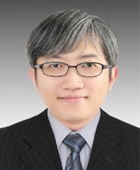
Assistant Professor in the Department of Prosthodontics, School of Dentistry, Pusan National University. His research interests include digital dentistry and computational analysis.
E-mail: prostho.hjlee@pusan.ac.kr

Assistant Professor in the Department of Mechanical Engineering, Kyungpook National University. His research interests include computational mechanics, structural dynamics, biomechanics and design optimization of structures.
E-mail: gunwoo@knu.ac.kr

